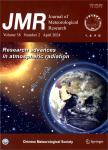Mechanisms for Marine–Terrestrial Compound Heatwaves in Southern China and Adjacent Oceans
作者机构:State Key Laboratory of Severe WeatherChinese Academy of Meteorological SciencesChina Meteorological Administration
出 版 物:《Journal of Meteorological Research》 (气象学报(英文版))
年 卷 期:2024年第05期
页 面:845-860页
核心收录:
学科分类:07[理学] 070601[理学-气象学] 0706[理学-大气科学]
基 金:Supported by the National Natural Science Foundation of China (42375041) Joint Research Project for Meteorological Capacity Improvement (22NLTSZ002) China Meteorological Administration Youth Innovation Group (CMA2024QN06)
摘 要:Extreme heat events over both lands and oceans have increased in frequency and intensity, and exerted profound impacts on human and natural systems. More impactful is their concurrence, leading to larger losses in health, food,economy, and ecosystem, but receiving far less attention. Understanding the mechanism for such marine–terrestrial compound heatwaves is a prerequisite to prediction and disaster prevention. Based on air particle trajectory analysis,we identified 87 compound heatwaves in China and adjacent oceans in summers of 1982–2021,with the connection between marine and terrestrial heatwaves particularly prominent between the oceans to Northeast Philippines and the lands in South/Southeast China. Through composite and case analysis, it is found that the connection is established by simultaneous governance of(i) the western Pacific subtropical high(WPSH),(ii) a dipole circulation pattern constituted by the WPSH and weak tropical cyclones(TCs), or(iii) strong and closer-to-coast TCs, each of which causes anomalously strong descending motion, increased incoming solar radiation, and strengthened adiabatic heating on lands. The marine heatwaves act to supply more moisture through enhanced evaporation, and/or intensify TCs that pass the region. The air particle tracking shows that these moister air masses are then advected by the WPSH and/or TCs to South/Southeast China, converting the adiabatic heating-caused dry heatwaves there into humid ones and thus adding to the heat stress. These diagnoses provide new insight into the mechanistic understanding and forecast precursors for terrestrial heatwaves, through the lens of compound events.



